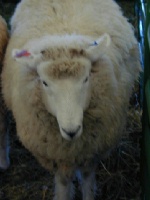All About Wool
Since at least 4000 B.C., humans have used wool to warm and protect them from the elements. It's elastic, flame-resistant, and can absorb up to one-third of its weight in moisture before it begins to feel moist.

More than Meets the Eye
To the untrained eye and hand, wool is a generic substance produced by a generic sheep, rather like thinking that wine comes in just two colors, red and white.
But just as with grapes and wine, there are hundreds of sheep breeds, each of which produces a unique fiber (or fleece) with its own distinct traits and characteristics. Fiber crimp, diameter, color, length, and color vary significantly from sheep to sheep.
Inside a Strand
Wool is an animal protein fiber comparable to hair on humans. It's made up of an outer membrane (or cuticle) and inner portion (or cortex). The cortex produces the overall curl and shape of the fiber.
A single layer of overlapping scale covers the cuticle. Depending on the composition of these scales, wool can appear shiny, bright, or chalky.
General Types
There are three general categories of wool: fine, long, and down. Fine wools tend to be softer, blend nicely with other fibers, and felt well. Because the scales on fine-wool fibers are irregular, these fibers often appear bright but not shiny.
Examples of fine-wool sheep breeds include Corriedale, Rambouillet, and the oldest, finest of them all, Merino. (Click here to read more about Merino.)
Long Wools
Long wools lack the softness of fine wools but make up for it in durability. Because the scales on fine wools are long, thin, and barely overlap, the fiber tends to be smooth and shiny. Long wool breeds include English Leicester, Romney, and Wensleydale.
Down Wools
Rounding out the mix are down wools, which are extremely elastic, resilient, and springy. Down-wool yarns have great loft and bulk, making them excellent for durable, warm sweaters. Many textile mills use down wools for blankets, as well.
Down wools don't felt easily and have little luster. Example breeds include Southdown, Suffolk Down, and Dorset Down.
Other Differences
Fleece characteristics can vary considerablly even among the same breed. And even the fleece from one sheep varies greatly depending on from where on the body it was shorn.
Fiber preparation and spin also impact yarn. Two identical fleeces, prepared and spun differently, can look totally unalike.
This is where it pays to learn how to spin your own yarn. Once you can do this, you'll be able to pick your breed and fleece and blend to your heart's content.
 Go to yarn reviews section
Go to yarn reviews section